
Mark Elly
About the Author
Mark studies history and strives to get more than just formal lectures and seminars. He is strongly interested in numismatics—this discipline allows to touch history with own hands, literally. In this blog, Mark shares his findings in designs, auction trends, new scientific research, and much much more. Stay here for more updates!
Connect with Mark:



Is There Something Special About the Value of 1964 Penny?
If you’ve stumbled upon an old tiny coin and are curious about the 1964 copper penny value, you’re not alone. This humble coin, often overlooked in pocket change, can be worth far more than its face —especially if you know what to look for. Let’s explore the history, features, grading, 1964 penny value today, and rare errors that make this one a favorite among collectors.
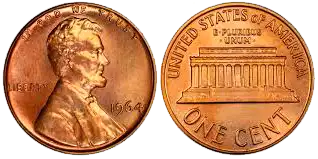
History & Background of the 1964 Penny
The 1964 Lincoln cent holds a notable place in American numismatic history. Introduced as part of an evolving U.S. coinage landscape, this particular cent bridges tradition and transition in U.S. Mint practices.
Why Was 1964 a Special Year for Pennies?
While this simple coin may appear ordinary, the year marked significant shifts in U.S. coinage:
- Massive Mintage: The country faced a severe coin shortage in the early 1960s. To address this, the U.S. Mint dramatically increased cents’ production. Over 4 billion pennies were struck in 1964—one of the largest mintages for any U.S. coin at the time.
- Last Year of 95% Copper: The 1964 cent was the final regular-issue U.S. penny struck using the traditional 95% copper / 5% zinc alloy. Starting in 1965, composition changes were introduced due to rising metal costs, and later years saw the transition to copper-plated zinc.
- Philadelphia Mint Produced “No Mint Mark” Pennies: 1964 pennies struck in Philadelphia bear no mint mark, a common practice at the time. Denver coins feature a small “D” under the date. The San Francisco Mint struck only proof coins in 1964—not circulation coins.
For collectors, these factors mark an intriguing transitional issue that bridges America’s numismatic past and future.
Key Features of the 1964 Penny
The obverse (front) features the instantly recognizable profile of Abraham Lincoln, sculpted by famed designer Victor David Brenner. This design debuted in 1909 to celebrate the 100th anniversary of Lincoln’s birth and became the first U.S. coin to depict a real person.
On the reverse (back), by 1964 the wheat stalks of the earlier design had been replaced by the Lincoln Memorial design, introduced in 1959. This image, created by Frank Gasparro, features the stately memorial building in Washington, D.C., with Lincoln’s statue visible between the columns—a subtle but elegant tribute.
Physical Characteristics
| Feature | Details |
| Weight | 3.11 grams |
| Composition | 95% copper, 5% zinc |
| Diameter | 19.05 mm (0.75 inches) |
| Edge | Plain (smooth, no reeding) |
These specifications are consistent across both Philadelphia (no mint mark) and Denver (D mint mark) 1964 cents, the only difference is in the letter, and the quality of mintage sometimes.
How to Identify a 1964 No Mint Mark Penny
With billions of 1964 pennies in circulation, proper identification is key. Here’s a quick guide to ensure you’re looking at a genuine 1964 no mint mark cent—and not a similar coin from another mint or year.
Where to Look for the Mint Mark
- No Mint Mark = Philadelphia Mint: A true 1964 no mint mark penny comes from the Philadelphia Mint, which did not use mint marks on circulating coins at that time.
- “D” = Denver Mint: If you see a small “D” below the date, the coin was struck in Denver. These coins can hold a high value of 1964 D penny.
- San Francisco Proofs: The San Francisco Mint produced proof coins only in 1964, intended for collectors. These display extremely sharp details and mirror-like finishes, and 1964 S penny value is one of the highest for this year’s issue.
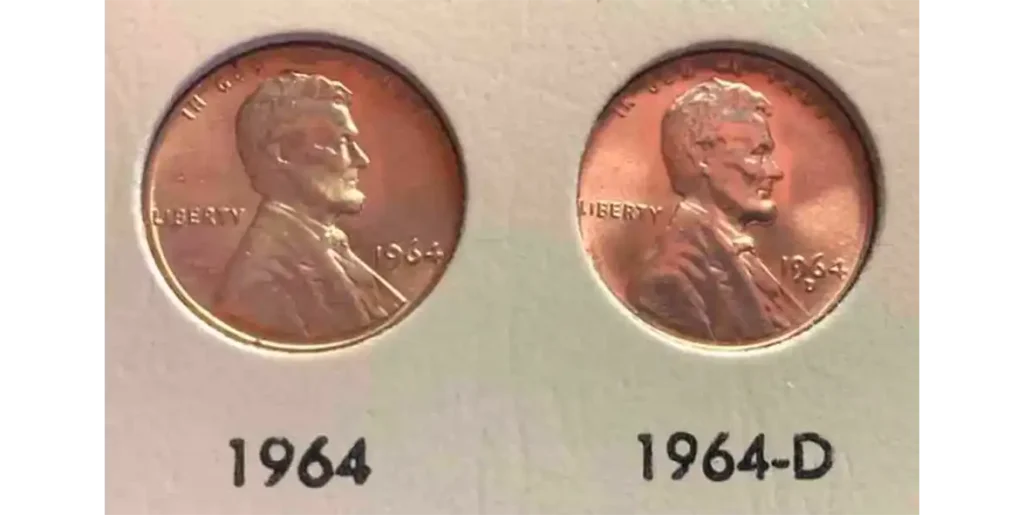
Examine the obverse side (where the Lincoln’s portrait is struck) — use a magnifying glass for clarity. Look directly below the date (“1964”) on the right-hand side — what can you see? If there is no letter beneath the date, congratulations—you have a Philadelphia-minted no mint mark penny.
Common Grading & Wear Patterns
Once you’ve identified the 1 cent coin in your hands, the next step is to evaluate its condition—a key factor in determining 1964 no mint penny value.
Circulated Grades (Good to About Uncirculated)
- Good (G) to Very Fine (VF): Coins will exhibit noticeable wear, especially on high points like Lincoln’s cheek, jaw, and hair. Reverse details (Lincoln Memorial) will appear flattened.
- Extremely Fine (EF): Moderate wear is visible but major design elements remain distinct. Some luster may remain around protected areas.
- About Uncirculated (AU): Minimal wear on high points. Majority of original luster remains.
Uncirculated (Mint State) Grades
Coins that show no wear and retain full luster qualify as Mint State (MS) examples:
- MS60–MS62: Attractive but may have some bag marks or minor imperfections.
- MS63–MS64: Good eye appeal, minimal marks, and strong luster.
- MS65–MS67: Sharp details, original red color, no visible wear, and excellent overall presentation.
1964 Penny Value No Mint Mark by Condition
Now that you know how to identify and grade your 1964 no mint mark penny, let’s talk about 1964 penny value D, S, and P. While most circulated examples hold only modest 1964 Lincoln penny value, uncirculated specimens and rare error coins can bring significant premiums.
Current Value Chart (2024 Estimates)
The following chart shows approximate retail 1964 penny no mint mark value in Red (RD) condition. RD indicates the coin retains its original bright copper color, which is highly desirable among collectors.
| Grade | Value (Red – RD) |
| MS63 | $6 |
| MS65 | $18 |
| MS67 | $1,000 |
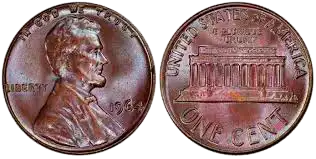
Notes:
- MS63: Entry-level Mint State coin, affordable for most collectors.
- MS65: High-quality piece suitable for more advanced collections.
- MS67: Exceptional example with nearly perfect surfaces and blazing original color—extremely rare and highly sought after. The most valuable 1964 D penny value will be found exactly in this class.
These prices are based on real auction records in 2024 and might vary when time passes. Usually coin prices rise slightly each year, due to less high-grade samples being found and sold.
Factors That Increase Value of a 1964 Penny
Not all 1964 no mint mark pennies worth more than face just because of their age. Here are the top factors that drive 1964 wheat penny value higher:
- Red (RD) Color: The brighter and more original the copper color, the more a coin will command on the market. Over time, copper darkens to brown, so true RD coins are relatively scarce.
- Full Strikes: Coins with sharp, well-defined details—especially on Lincoln’s hair and the steps of the Memorial—tend to sell for premiums.
- Certified by PCGS/NGC: Coins that are professionally graded and encapsulated by top-tier services like PCGSor NGC inspire more buyer confidence and often sell for higher prices.
Rare Errors & Varieties to Look For
In addition to high-grade specimens, certain error coins and varieties of the 1964 penny can cost quite a lot, such as 1964 D penny error l on the edge value ($500 and higher). These anomalies result from mistakes during the minting process and are identified by specialists.
Valuable 1964 Penny Errors
Here are the most notable errors collectors hunt for:
- Doubled Die Obverse (DDO):
Some 1964 pennies display noticeable doubling of the design on the obverse, particularly in the inscriptions “LIBERTY,” “IN GOD WE TRUST,” and the date.- Value Range: $200–$5,000, depending on grade and eye appeal.
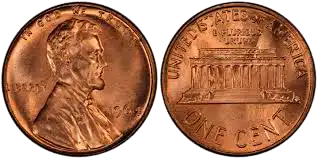
- Off-Center Strikes:
A coin that was not properly centered during striking will show part of the design shifted toward one edge. The more off-center, the rarer and more valuable it becomes (though at least 10% off-center is preferred by collectors).- Value Range: $10–$100+ depending on the degree of the strike.
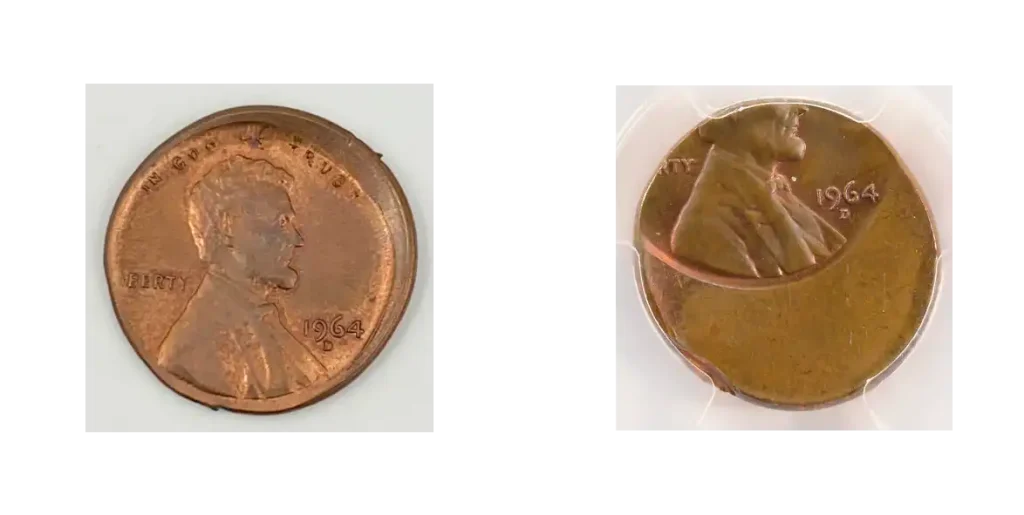
- Repunched Mint Marks (RPMs):
RPMs apply only to 1964-D pennies, but they’re worth mentioning for completeness. These occur when the mint mark punch was applied twice in slightly different positions.- Value Range: $50–$300.
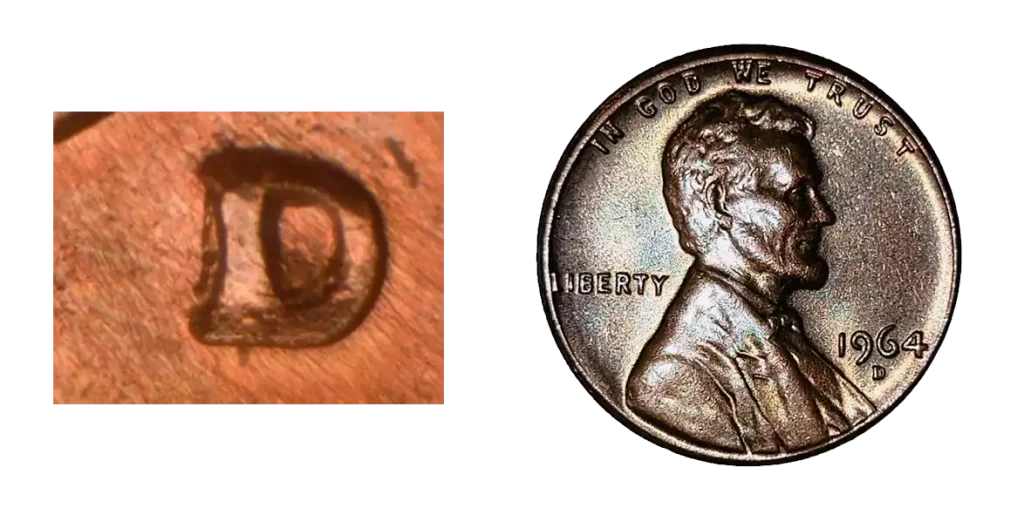
How to Spot Errors
To determine whether your 1964 penny harbors a 1964 D penny value error, follow these steps:
- Use a 10x magnifier or loupe to carefully inspect the coin.
- Look for doubling on the lettering—especially LIBERTY and the date.
- Examine the entire coin for signs of off-center striking, such as uneven rims or missing design elements.
- Be aware that RPMs do not apply to Philadelphia-minted no mint mark coins, but if you’re checking 1964-D pennies, inspect the mint mark closely.
Pro Tip: Use Coin ID Scanner for quick identification. If you’ve got a couple of pennies, scan them via the app before getting them graded — it might save your time and money. The AI-powered search will identify your coin and provide you with recent 1964 no mint mark penny value charts. You can even keep a digital collection record to organize your belongings.
FAQs
As interest in mid-century coinage continues to grow, many collectors—both new and experienced—have common questions. Let’s address some of the most frequent ones to help you better understand the true potential of your coin.
How much is a 1964 no mint mark penny worth?
- Circulated coins 1964 penny D mint mark value is about 2–5 cents, depending on condition.
- Uncirculated (Mint State) Red examples start at about $6 (MS63) and can reach $1,000 or more (MS67 RD).
- Error coins such as Doubled Die Obverse or off-center strikes can bring $200–$5,000 depending on rarity and eye appeal.
- Special Mint Set (SMS) pennies, while extremely rare and mostly documented for the 1964-D version, are a hot topic among advanced collectors.
What makes a 1964 penny valuable?
Several factors can transform an ordinary strike into a prized collectible:
- Condition: Uncirculated, especially MS65+ RD coins.
- Color: Retaining bright original Red (RD) surfaces adds significant penny 1964 value.
- Errors & Varieties: DDOs, off-center strikes, and in some cases, experimental SMS coins.
- Certification: Graded by a trusted third-party grading service such as PCGS or NGC.
Are there any rare 1964 penny errors?
Yes. Here are some of the most sought-after value rare error 1964 D penny error and varieties:
- Doubled Die Obverse (DDO) — Look for doubling on LIBERTY, IN GOD WE TRUST, and the date.
- Off-Center Strikes — More off-center = higher 1964 penny value error.
- Repunched Mint Marks (RPMs) — For 1964-D only, not the Philadelphia no mint mark version.
- Special Mint Set (SMS) 1964 cents — An extremely rare and controversial variety primarily known in 1964-D coins but worth researching.
Where is the mint mark on a 1964 penny?
Look directly below the date on the obverse (front) of the coin:
- No mark = Philadelphia Mint.
- “D” = Denver Mint.
- San Francisco (S) — Only proof coins were made, not for circulation.
How can I tell if my 1964 penny is uncirculated?
Uncirculated 1964 pennies will display:
- Full mint luster—a vibrant cartwheel effect under light.
- No wear on high points such as Lincoln’s cheek and jawline.
- Sharp details on the Lincoln Memorial steps.
- No distracting scratches, nicks, or discoloration.
If your coin shows even the slightest wear, it is no longer technically graded as uncirculated.
Should I clean my cent to increase the valuable 1964 penny value?
Absolutely not. Cleaning a coin destroys its natural surfaces, significantly reducing its collectible penny 1964 D value. Seasoned collectors and professional graders can immediately spot a cleaned coin, and it will typically receive a “Details” grade—hurting both desirability and resale 1964 D wheat penny value.
Pro tip: Leave your coin as is and store it properly. If you suspect it’s valuable, get it graded before making any decisions about handling or selling it.
Where can I sell a valuable 1964 penny?
For coins with true collectible 1964 d penny value today (errors, high grade, etc.), your best options are:
- Reputable coin dealers — Seek those with good reviews and experience in U.S. coins.
- Online auction platforms — eBay or dedicated numismatic auction houses like Heritage Auctions or GreatCollections.
- Coin shows — Ideal for networking and direct sales.
- Certified coins (PCGS/NGC) will command much higher prices and are easier to sell to serious collectors.
This year’s issue may be one of the most common Lincoln cents ever produced, but that doesn’t mean it lacks potential for 1964 p penny value or intrigue. With careful attention to condition, color, and possible errors or varieties, collectors can find exciting opportunities in this otherwise modest coin.
Remember:
- Most circulated 1964 pennies are worth just a few cents.
- Uncirculated Red (RD) coins and error varieties can command serious premiums.
- Use trusted resources like the Coin ID Scanner app to assess your coin’s potential before selling or submitting for professional grading.
Armed with knowledge—and the right tools—you just might discover that your 1964 penny is worth far more than face.